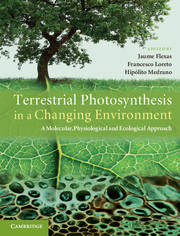 Terrestrial Photosynthesis in a Changing Environment
Terrestrial Photosynthesis in a Changing Environment Book contents
- Frontmatter
- Contents
- List of contributors
- Preface
- Acknowledgements
- List of abbreviations
- 1 Terrestrial photosynthesis in a changing environment
- Part I Photosynthesis
- Part II Measuring photosynthesis
- Part III Photosynthetic response to single environmental factors
- 16 Photosynthetic responses to radiation
- 17 Photosynthetic responses to increased CO2 and air pollutants
- 18 Response of photosynthesis to low temperature
- 19 Photosynthetic responses to high temperature
- 20 Photosynthesis under water deficits, flooding and salinity
- 21 Photosynthetic responses to nutrient deprivation and toxicities
- 22 Photosynthetic responses to biotic stress
- Part IV Photosynthesis in time
- Part V Photosynthesis in space
- Part VI Photosynthesis in a global context
- References
- Index
16 - Photosynthetic responses to radiation
Published online by Cambridge University Press: 05 March 2013
- Frontmatter
- Contents
- List of contributors
- Preface
- Acknowledgements
- List of abbreviations
- 1 Terrestrial photosynthesis in a changing environment
- Part I Photosynthesis
- Part II Measuring photosynthesis
- Part III Photosynthetic response to single environmental factors
- 16 Photosynthetic responses to radiation
- 17 Photosynthetic responses to increased CO2 and air pollutants
- 18 Response of photosynthesis to low temperature
- 19 Photosynthetic responses to high temperature
- 20 Photosynthesis under water deficits, flooding and salinity
- 21 Photosynthetic responses to nutrient deprivation and toxicities
- 22 Photosynthetic responses to biotic stress
- Part IV Photosynthesis in time
- Part V Photosynthesis in space
- Part VI Photosynthesis in a global context
- References
- Index
Summary
Basic characteristics of solar radiation
Among the factors affecting plants, solar radiation is perhaps the most heterogeneous in space and time. Important parts of solar radiation provide energy for photosynthesis and serve as signals in photoregulation of plant growth and development. The sun radiates energy in the spectral range from 280 to 4000 nm, with a maximum in the blue-green (480 nm; Fig. 16.1). Within the PAR, solar radiation peaks at ca. 590 nm (Fig. 16.1). Solar radiation can be segregated into direct solar radiation and diffuse sky radiation, which reaches the ground after multiple scattering on atmospheric particles and clouds, reflection from the ground surface and additional scattering in the atmosphere (Ross, 1981).
The widespread, albeit vague, term light is used for the portion of the electromagnetic spectrum in the vicinity of visible light (Kohen et al., 1995). Many past ecological and physiological studies were based on measurements that represent the stimulation of the human eye by radiant energy, a measure called illuminance and expressed in foot-candles (English system) or luxes (metric system). The human eye is most sensitive in the green spectral region, centered around 550 nm, whereas any quanta in the spectral region of 400–700 nm have enough energy to drive photosynthesis, so illuminance is obviously not well suited for plant science.
- Type
- Chapter
- Information
- Terrestrial Photosynthesis in a Changing EnvironmentA Molecular, Physiological, and Ecological Approach, pp. 239 - 256Publisher: Cambridge University PressPrint publication year: 2012
- 12
- Cited by
